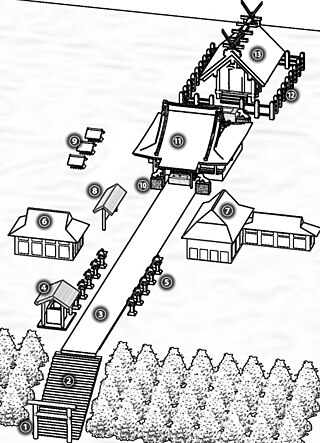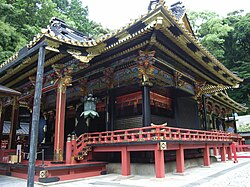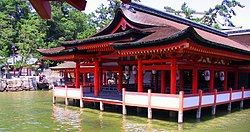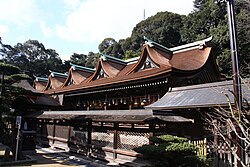Top Qs
Timeline
Chat
Perspective
List of National Treasures of Japan (shrines)
From Wikipedia, the free encyclopedia
Remove ads
Remove ads
The number of Shinto shrines in Japan today has been estimated at more than 150,000.[1] Single structure shrines are the most common. Shrine buildings might also include oratories (in front of main sanctuary), purification halls, offering halls called heiden (between honden and haiden), dance halls, stone or metal lanterns, fences or walls, torii and other structures.[2] The term "National Treasure" has been used in Japan to denote cultural properties since 1897.[3] The definition and the criteria have changed since the inception of the term. The shrine structures in this list were designated national treasures when the Law for the Protection of Cultural Properties was implemented on June 9, 1951. As such they are eligible for government grants for repairs, maintenance and the installation of fire-prevention facilities and other disaster prevention systems. Owners are required to announce any changes to the National Treasures such as damage or loss and need to obtain a permit for transfer of ownership or intended repairs.[4] The items are selected by the Ministry of Education, Culture, Sports, Science and Technology based on their "especially high historical or artistic value".[5][6] This list presents 43[nb 1][nb 2] entries of national treasure shrine structures from 12th-century Classical Heian period to the early modern 19th-century Edo period. The number of structures listed is actually more than 43, because in some cases groups of related structures are combined to form a single entry. The structures include main halls (honden), oratories (haiden), gates, offering halls (heiden), purification halls (haraedono) and other structures associated with shrines.[6]

Remove ads
History
Summarize
Perspective
The practice of marking sacred areas began in Japan as early as the Yayoi period (from about 500 BC to 300 AD) originating from primal religious beliefs. Features in the landscape such as rocks, waterfalls, islands, and especially mountains, were places believed to be capable of attracting kami, and subsequently were worshiped as yorishiro.[7] Originally, sacred places may have been simply marked with a surrounding fence and an entrance gate or torii.[8] Later, temporary structures similar to present day portable shrines[9] were constructed to welcome the gods to the sacred place, which eventually evolved into permanent buildings that were dedicated to the gods. Ancient shrines were constructed according to the style of dwellings (Izumo Taisha)[7][10] or storehouses (Ise Grand Shrine).[7][8] The buildings had gabled roofs, raised floors, plank walls, and were thatched with reed or covered with hinoki cypress bark.[8] Such early shrines did not include a space for worship.[7] Three important forms of ancient shrine architectural styles exist: taisha-zukuri,[ex 1] shinmei-zukuri[ex 2] and sumiyoshi-zukuri.[ex 3][1][9] They are exemplified by Izumo Taisha, Nishina Shinmei Shrine and Sumiyoshi Taisha,[11] respectively, and date from before 552 AD.[12] According to the tradition of Shikinen sengū-sai (式年遷宮祭), the buildings or shrines were faithfully rebuilt at regular intervals adhering to the original design. In this manner, ancient styles have been replicated through the centuries to the present day.[nb 3][10][13][14]
Beginning in the mid-6th century, as Buddhism was brought to Japan from Baekje, new styles of shrine architecture were introduced; today's Shinto shrine blueprint is of Buddhist origin.[15] The concept of temples as a place of assembly was applied to shrines. Spaces for worship were added in the form of extended roofs or worship halls (haiden) in addition to the main hall (honden).[7] The following stylistic elements of Buddhist temple architecture were assimilated and applied to Japanese shrines: column-base stones,[nb 4] brackets, curved roofs, painted surfaces, metal ornaments, corridors and pagodas.[7][8][16] At the end of the 8th century as architectural styles evolved, new elements were added as is evident in kasuga-zukuri[ex 4] (Kasuga Shrine and Hakusandō/Kasugadō at Enjō-ji), the flowing roof or nagare-zukuri[ex 5] (Shimogamo Shrine), hachiman-zukuri[ex 6] (Usa Shrine) and hiyoshi-zukuri[ex 7] (Hiyoshi Taisha).[17][18] The nagare-zukuri continues to be the more popular style, followed by the kasuga-zukuri.[7][14] The honden of Ujigami Shrine dates to this period.[19] At the end of the Heian period torii and fences were commonly replaced with two-storied gates and grand colonnades copied from temple architecture. The influence of the residential shinden-zukuri style of palaces and mansions is apparent in shrines such as Itsukushima Shrine.[20]
The auxiliary Marōdo Shrine at Itsukushima Shrine originates from the 13th-century Kamakura period, and the honden and haiden of the Kibitsu Shrine date from the 15th-century Muromachi period.[21] In the late 16th century and early 17th century, during the Momoyama period, gongen-zukuri was introduced as a new plan of building shrines. The main hall was joined to the oratory via a connecting structure called the ai-no-ma, derived from the hachiman-zukuri style. Examples of gongen-zukuri are the honden at Kitano Tenman-gū and Ōsaki Hachiman Shrine.[22] Tōshō-gū dates from the Edo period and was completed in 1636. It is a complex assembly of richly adorned shrines, temples and a mausoleum.[23] Such complexes are a result of the syncretism of Shinto and Buddhism which began to appear during the Heian period; Kitano Tenman-gū, built in 947 for the spirit of Sugawara no Michizane, was the first of these byō or jingū-ji.[7][24]
Remove ads
Statistics
Summarize
Perspective
The 43[nb 1][nb 2] entries in the list consist of the following: main halls (honden), combined structures of honden, haiden with or without an ai-no-ma or heiden in between, oratories (haiden), offering halls (heiden), corridors, gates, fences, purification halls and other halls that are related to a shrine.

Remove ads
Usage
The table's columns (except for Remarks and Images) are sortable pressing the arrow symbols.
- Name: name of the structure as registered in the Database of National Cultural Properties[6][nb 1][nb 2]
- Shrine: name of the shrine in which the structure is located
- Remarks: architecture and general remarks including
- size measured in ken, or distance between pillars; "m×n" denotes the length (m) and width (n) of the structure, each measured in ken
- architectural style (zukuri) and type of roofing
- existence of bargeboards, forked roof finials (chigi), step canopies, etc
- Date: period and year of the last major reconstruction; The column entries sort by year. If only a period is known, they sort by the start year of that period.
- Location: "town-name prefecture-name"; The column entries sort as "prefecture-name town-name".
- Images: picture of the structure; If the image shows more than one structure, the respective structure is indicated by a blue rectangle.
Treasures
Summarize
Perspective
Remove ads
See also
- For an explanation of terms concerning Shinto, shrines and shrine architecture, see the glossary of Shinto.
Notes
Architecture
- (shinmei-zukuri, 神明造): ancient style of Shinto shrine architecture consisting of a small structure, that is either 3 ken×2 ken or 1 ken×1 ken, raised several steps above ground level surrounded by a railed veranda. Generally it has a simple gable roof with forked finials called chigi. The entrance is on a side parallel to the ridge.[14][34]
- (kasuga-zukuri, 春日造): a shrine style resembling that of Kasuga Taisha with (generally) a small 1 ken×1 ken honden. The roof is gabled and has an attached pent roof covering the entrance stairway which is located on the gable side. This is, next to the nagare-zukuri, the second most common style of shrine architecture.[14][66]
- (nagare-zukuri, 流造): gable roof with a slightly curved short rear roof and a long deeply curved front roof covering both the step-canopy and pent roof over the veranda and steps. The entrance is on the long side, the side parallel to the ridge. The building's width is between one and eleven ken. This is the most common style of shrine architecture.[14][89]
- (hachiman-zukuri, 八幡造): a style of shrine architecture characterised by a structure which appears from the side as two separate buildings with their gabled roofs joined by a rain gutter. The space between the buildings is enclosed and 1 ken wide. The entrances are in the center of each building on the side parallel to the ridges. The front structure is the outer sanctuary (外殿, gai-den), that at the rear the inner sanctuary (内殿, nai-den). Together they form the main hall (honden).[14][95]
- (hiyoshi-zukuri or hie-zukuri, 日吉造): a style unique to the main buildings of Hiyoshi Taisha. From the front, the building appears like a 5 ken wide structure with hip-and-gable irimoya style roof and an entrance from the central step canopy. From the side, the eave appears shorn off midway giving the rear roof a trapezoidal form. The core of the building is 3 ken×2 ken to which 1 ken wide aisles are added on three sides making it a 5 ken×3 ken structure.[14][46]
- (irimoya-zukuri, 入母屋造): a hip-and-gable roof combining a ridge and two gable pediments on the upper part with a hipped roof on all sides in the lower part of the roof.[26]
- (chidori hafu, 千鳥破風, lit. "plover gable"): a decorative dormer bargeboard on triangular shaped dormers with strong concave curves.[28]
- (karahafu, 唐破風): an undulating bargeboard flowing downwards from the top center with convex curves on each side that change to concave curves which either level off or turn upward at the ends.[29]
- (kirizuma-zukuri, 切妻造): a gabled roof with equal lengths from the ridge to the eaves.[36]
- (hiyoku irimoya-zukuri, 比翼入母屋造): a hip-and-gable roof exemplified by the one of Kibitsu Shrine with the main ridges of the roof parallel to the long side of the honden and ridges perpendicular to the main ridge creating two gables on each side of the ridge.[14][81]
- (yosemune-zukuri, 寄棟造): a hipped roof where the front and back are trapezoidal and the sides triangular in shape; in Japan generally used for buildings of less importance.[91]
General
- The National Treasure structures of Itsukushima Shrine are interconnected and registered as a single National Treasure under one registration number. Only in the main treasure table of this article, the single entry is split in parts for readability.
- The National Treasure structures of Aoi Aso Shrine are registered as a single National Treasure under one registration number. Only in the main treasure table of this article, the single entry is split in parts for readability.
- Presently only the Ise Grand Shrine is rebuilt every 20 years.
- Before wooden columns were placed directly in the ground.
- If a National Treasure was constructed during more than one period, only the oldest period is counted.
- One munafuda (棟札) ridge tag with information on the building's construction is attached to the nomination.
- The following items are attached to the nomination:
- bell house (鐘舎, shōsha),
- tōdaihoya (燈台穂屋) hut,
- sacred copper-plated storehouse (銅神庫, dōjinko),
- connection corridor (渡廊, watarō),
- gate of copper warehouse (銅庫門, dōko-mon),
- God's rest room (西浄, saijō),
- two iron fire baskets for lanterns (鉄燈籠),
- nine copper boxes with implements for the memorial service of the dead (銅箱入供養具),
- two side entrances (妻戸, tsumado),
- east passage gate (東通用御門, higashi tsuyōgō-mon) or 社家門 (shake-mon),
- 104 stone lanterns (石燈籠, ishitōrō),
- the road approaching the shrine (参道, sandō),
- emergency gate (非常門, hijō-mon)
- guard house (内番所, uchibansho)
- 16 copper fire baskets for lanterns (銅燈籠)
- one box of carpenter implements (箱入大工道具)
- one lamp stand (燈台)
- a stone fence,
- a torii.
- Two former ceiling boards are attached to the nomination.
- The following items are attached to the nomination:
- road from the Deva gate to the shrine,
- 66 copper fire baskets for lanterns,
- 249 stone lanterns,
- a stone fence,
- one miniature shrine,
- nine copper boxes with implements for the memorial service of the dead,
- one munafuda (棟札) ridge tag with information on the building's construction.
- The following items are attached to the nomination:
- a set of eleven implements for the Anchin-hō ceremony of Esoteric Buddhism
- road approaching the shrine
- two copper lanterns
- a stone font for ritual cleansing
- one munafuda (棟札) ridge tag with information on the building's construction
- six two hanging lanterns
- The nomination includes a dais and a miniature shrine.
- Attached to the nomination is one miniature shrine.
- Eleven munafuda (棟札) ridge tags with information on the building's construction are attached to the nomination.
- One munafuda (棟札) ridge tag with information on the building's construction and one miniature shrine are attached to the nomination.
- A total of eight subordinate shrine honden and a see-through fence are attached to the nomination.
- Six munafuda (棟札) ridge tags with information on the building's construction are attached to the nomination.
- A mizugaki (瑞垣) fence with vertically set boards and a gate are included in the nomination.
- Six munafuda (棟札) ridge tags with information on the building's construction are attached to the nomination.
- The Aizen-dō (愛染堂) hall, 43 pieces of ancient lumber and one munafuda (棟札) ridge tag with information on the building's construction are attached to the nomination.
- The nomination includes the inner shrine (内殿) and one munafuda (棟札) ridge tag with information on the building's construction.
- The nomination includes an inner shrine and an ancient pillar called shin no mihashira (心御柱).
- The nomination includes two munafuda (棟札) ridge tags with information on the building's construction.
- The nomination includes the fence around the shrine and the left and right Naishi-bashi (内待橋), which are the bridges passed by women serving at the court (naishi) on their way to offer food for the gods.
- The nomination includes:
- four munafuda (棟札) ridge tags with information on the building's construction,
- the High Stage (高舞台, takabutai) in front of the haraedono which is used for bugaku dance performances,
- the Open Stage (平舞台, hirabutai) in front of the main shrine,
- the left and right Kadomarōdo shrines (門客神社, kadomarōdojinja) located in front of the main shrine to either side of the hitasaki front lantern. The gate guards, toyoiwamado no kami (豊石窓神) and kushiiwamado no kami (櫛石窓神) are enshrined in them,
- the left and right gakubō (楽房) gagaku dance music halls in front of the main shrine, one for each type of gagaku dance: "left dance" from India and the Tang dynasty, "right dance" from China and Korea.
- The nomination includes the fence around the shrine.
- 19 munafuda (棟札) ridge tags with information on the building's construction are attached to the nomination.
- Four munafuda (棟札) ridge tags with information on the building's construction and five miniature shrines (玉殿, gyokuden) are attached to the nomination.
- One munafuda (棟札) ridge tag with information on the building's construction and five inscription boards (銘札) are attached to the nomination.
Remove ads
References
Further reading
External links
Wikiwand - on
Seamless Wikipedia browsing. On steroids.
Remove ads






























































